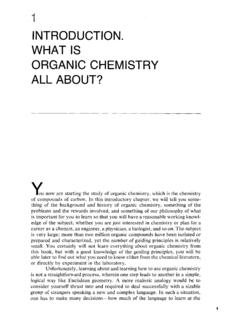Transcription of 18 LABORATORY QUALITY CONTROL - US EPA
1 18 laboratory quality control . Introduction This chapter addresses internal LABORATORY QUALITY CONTROL (QC), the purpose of which is to monitor performance, identify problems, and initiate corrective action. If project requirements are more stringent than typical LABORATORY QC criteria, the project manager and the LABORATORY should confer to see whether the LABORATORY can accommodate the project QC requirements. Project QC. requirements are addressed in Part I of MARLAP. LABORATORY data should be produced under a QUALITY system1 that incorporates planning, implementing, and internal assessment of the work performed by the LABORATORY , including QC.
2 MARLAP fully endorses the need for a LABORATORY QUALITY system and a QUALITY manual that delineates the QUALITY assurance (QA) policies and QC practices of the LABORATORY . A LABORATORY s QUALITY system should ensure that LABORATORY processes and measurements are in statistical CONTROL , which means that the distribution of measured results is stable. This chapter s purpose is to provide guidance to LABORATORY staff on those activities and profes- sional practices a radioanalytical LABORATORY should undertake to produce data of known QUALITY . This chapter also shows how to use statistical techniques to monitor specific measures of the analytical process to indicate the level of CONTROL of the analytical process within the LABORATORY .
3 These measures are called performance indicators, and the statistical techniques involve the use of CONTROL charts. Monitoring performance indicators through CONTROL charts enables the identification of trends. The LABORATORY can then address analytical problems and help improve the analytical process. Section and Attachment 18A at the end of this chapter provide examples of several types of charts. The use of statistical techniques is the preferred method for Contents implementing QUALITY CONTROL in the LABORATORY Introduction .. 18-1. (Attachment 18B). The chapter also identifies QUALITY CONTROL .
4 18-3. specific performance indicators, the principles Evaluation of Performance Indicators .. 18-3. that govern their use, indications and under- Radiochemistry Performance Indicators .. 18-9. lying causes of excursions, statistical means of Instrumentation Performance Indicators .. 18-24. Related Concerns .. 18-54. evaluating performance indicators, and References .. 18-65. examples of root-cause evaluations. Attachment 18A: CONTROL Charts .. 18-69. Attachment 18B: Statistical Tests for QC Results 18-81. 1. A QUALITY system is a structured and documented management framework that describes the policies, objectives, principles, organizational authority, responsibilities, accountability, and implementation plan of an organization for ensuring QUALITY in its work processes, products (items), and services.
5 The QUALITY system provides for planning, implementing, and assessing the work performed by the organization and for carrying out required QUALITY assurance and QUALITY CONTROL (ANSI/ASQC E4, 1994). General requirements for testing laboratories can be found in ISO/IEC. 17025. JULY 2004 18-1 MARLAP. LABORATORY QUALITY CONTROL This chapter addresses the CONTROL of the analytical process in the LABORATORY , as distinct from meeting the typical analytical needs of a specific project. QUALITY CONTROL provides quantitative estimates of analysis and measurement controls that can be used to determine compliance with project objectives.
6 Organization of Chapter Chapter 18 has five major sections in addition to this introduction. Section provides a general overview of QC and its application in the LABORATORY setting. Section discusses the importance of evaluating performance indicators and provides statistical means for their evalua- tion. Sections and identify primary radiochemistry and instrumentation performance indicators, respectively, and discuss each in detail. Section discusses other aspects of the analytical process that require scrutiny but are not formally considered performance indicators. Format The chapter is presented in a different format than the preceding chapters in order to highlight the performance indicators and to give examples.
7 For each performance indicator, general guidance is provided in the format shown below. Issue: Defines and summarizes the performance indicator Discussion: Identifies those matters important to the performance indicator, including: What is the performance indicator and how does it work? Why is the performance indicator important, and what is its impact on the QUALITY of the measurement? What is the relationship of the performance indicator and the combined standard uncertainty derived for the analytical method? What are the acceptable limits of the performance indicator? What are the key assumptions underlying the performance indicator?
8 What limits and cautions are associated with the assumptions made? How sensitive is the QUALITY of the measurement to the assumptions made? What is the appropriate frequency for assessing this performance indicator? MARLAP 18-2 JULY 2004. LABORATORY QUALITY CONTROL Excursions: Excursions are departures from the expected condition. This section addresses the likely types of excursions encountered during LABORATORY analysis and explains what each may indicate. This section also discusses the potential reasons for these excursions and the implications for the analytical results. Examples: Where appropriate, this section provides typical examples of excursions, potential reasons for excursions, and additional information.
9 QUALITY CONTROL QUALITY CONTROL includes all technical activities that measure the attributes and performance of a process, item, or service against defined standards to verify that they meet the stated require- ments established by the customer. It also includes operational techniques and activities that are used to fulfill requirements for QUALITY (ANSI/ASQC E4, 1994). QC may not always detect blunders. Good LABORATORY practices, in addition to adherence to standard operating procedures (SOPs), are part of the overall QA/QC aspects needed to check the LABORATORY s performance. To monitor and CONTROL QUALITY , laboratories use performance indica- tors, which are instrument- or protocol-related parameters that are routinely monitored to assess the LABORATORY s estimate of measurement uncertainty, precision, bias, etc.
10 Initially, these para- meters are used to maintain or demonstrate CONTROL over the analytical process. The performance indicators should be tracked by appropriate personnel. If the performance indicator CONTROL limits are exceeded, management should be informed and corrective action should be initiated. Figure lists some of the potential causes for radioanalytical CONTROL excursions. By no means is the list complete, and the reader should be aware of additional potential causes of excursions that are presented in the rest of this chapter and the other chapters. Many problems are complex and have multiple components that could complicate the search for causes of protocol or instru- ment related excursions.















